SLVS631C December 2005 – May 2015 TPS51117
PRODUCTION DATA.
- 1 Features
- 2 Applications
- 3 Description
- 4 Revision History
- 5 Pin Configuration and Functions
- 6 Specifications
-
7 Detailed Description
- 7.1 Overview
- 7.2 Functional Block Diagram
- 7.3
Feature Description
- 7.3.1 PWM Frequency and Adaptive On-Time Control
- 7.3.2 Low-Side Driver
- 7.3.3 High-Side Driver
- 7.3.4 Soft-Start
- 7.3.5 Powergood
- 7.3.6 Output Discharge Control (Soft-Stop)
- 7.3.7 Overcurrent Limit
- 7.3.8 Negative Overcurrent Limit (PWM-Only Mode)
- 7.3.9 Overvoltage Protection
- 7.3.10 Undervoltage Protection
- 7.3.11 Start-Up Sequence
- 7.3.12 UVLO Protection
- 7.3.13 Thermal Shutdown
- 7.4 Device Functional Modes
- 8 Application and Implementation
- 9 Power Supply Recommendations
- 10Layout
- 11Device and Documentation Support
- 12Mechanical, Packaging, and Orderable Information
Package Options
Refer to the PDF data sheet for device specific package drawings
Mechanical Data (Package|Pins)
- RGY|14
- PW|14
Thermal pad, mechanical data (Package|Pins)
- RGY|14
Orderable Information
6 Specifications
6.1 Absolute Maximum Ratings(1)
| MIN | MAX | UNIT | |||
|---|---|---|---|---|---|
| Input voltage | VBST | –0.3 | 36 | V | |
| VBST (with respect to LL) | –0.3 | 6 | |||
| EN_PSV, TRIP, V5DRV, V5FILT | –0.3 | 6 | |||
| VOUT | –0.3 | 6 | |||
| TON | –0.3 | 6 | |||
| Output voltage | DRVH | –1 | 36 | V | |
| DRVH (with respect to LL) | –0.3 | 6 | |||
| LL | –1 | 30 | |||
| PGOOD, DRVL | –0.3 | 6 | |||
| PGND | –0.3 | 0.3 | |||
| TA | Operating free-air temperature | –40 | 85 | °C | |
| TJ | Junction temperature | –40 | 125 | °C | |
| Lead temperature 1.6 mm (1/16 inch) from case for 10 seconds | 260 | °C | |||
| Tstg | Storage temperature | –55 | 150 | °C | |
(1) Stresses beyond those listed under Absolute Maximum Ratings may cause permanent damage to the device. These are stress ratings only and functional operation of the device at these or any other conditions beyond those indicated under Recommended Operating Conditions is not implied. Exposure to absolute-maximum-rated conditions for extended periods may affect device reliability.
6.2 Recommended Operating Conditions
over operating free-air temperature range (unless otherwise noted)| MIN | MAX | UNIT | ||
|---|---|---|---|---|
| Supply input voltage | 4.5 | 5.5 | V | |
| Input voltage | VBST | 4.5 | 34 | V |
| VBST (with respect to LL) | 4.5 | 5.5 | ||
| EN_PSV, TRIP, V5DRV, V5FILT | –0.1 | 5.5 | ||
| VOUT | –0.1 | 5.5 | ||
| TON | –0.1 | 5.5 | ||
| Output voltage | DRVH | –0.8 | 34 | V |
| DRVH (with respect to LL) | –0.1 | 5.5 | ||
| LL | –0.8 | 28 | ||
| PGOOD, DRVL | –0.1 | 5.5 | ||
| PGND | –0.1 | 0.1 | ||
| Operating free-air temperature, TA | –40 | 85 | °C | |
6.3 Electrical Characteristics
over operating free-air temperature range (unless otherwise noted)| PARAMETER | TEST CONDITIONS | MIN | TYP | MAX | UNIT | |
|---|---|---|---|---|---|---|
| SUPPLY CURRENT | ||||||
| IV5FILTPWM | Supply current | V5FILT + V5DRV current, PWM, EN_PSV = float, VFB = 0.77 V, LL = –0.1 V | 400 | 750 | μA | |
| IV5FILTSKIP | Supply current | V5FILT + V5DRV current, auto-skip, EN_PSV = 5 V, VFB = 0.77 V, LL = 0.5 V | 250 | 470 | μA | |
| IV5DRVSDN | V5DRV shutdown current | V5DRV current, EN_PSV = 0 V | 0 | 1 | μA | |
| IV5FILTSDN | V5FILT shutdown current | V5FILT current, EN_PSV = 0 V | 4.5 | 7.5 | μA | |
| VOUT AND VFB VOLTAGES | ||||||
| VOUT | Output voltage | Adjustable output range | 0.75 | 5.5 | V | |
| VVFB | VFB regulation voltage | 750 | mV | |||
| VVFB_TOL | VFB regulation voltage tolerance | TA = 25°C, bandgap initial accuracy | –0.9% | 0.9% | ||
| TA = 0°C to 85°C | –1.3% | 1.3% | ||||
| TA = –40°C to 85°C | –1.6% | 1.6% | ||||
| IVFB | VFB input current | VFB = 0.75 V, absolute value | 0.02 | 0.1 | μA | |
| RDischg | VOUT discharge resistance | EN_PSV = 0 V, VOUT = 0.5 V | 20 | 32 | Ω | |
| ON-TIME TIMER AND INTERNAL SOFT-START | ||||||
| TONN | Nominal on-time | VLL = 12 V, VOUT = 2.5 V, RTON = 250 kΩ | 750 | ns | ||
| TONF | Fast on-time | VLL = 12 V, VOUT = 2.5 V, RTON = 100 kΩ | 264 | 330 | 396 | ns |
| TONS | Slow on-time | VLL = 12 V, VOUT = 2.5 V, RTON = 400 kΩ | 1169 | ns | ||
| TON(MIN) | Minimum on-time | VOUT = 0.75 V, RTON = 100 kΩ to 28 V(1) | 80 | 110 | 140 | ns |
| TOFF(MIN) | Minimum off-time | VFB = 0.7 V, LL = –0.1 V, TRIP = open |
440 | ns | ||
| TSS | Internal soft-start time | Time from EN_PSV > 3 V to VFB regulation value = 0.735 V |
0.82 | 1.2 | 1.5 | ms |
| OUTPUT DRIVERS | ||||||
| RDRVH | DRVH resistance | Source, VVBST-DRVH = 0.5 V | 5 | 7 | Ω | |
| Sink, VDRVH-LL = 0.5 V | 1.5 | 2.5 | ||||
| RDRVL | DRVL resistance | Source, VV5DRV-DRVL = 0.5 V | 5 | 7 | Ω | |
| Sink, VDRVL-PGND = 0.5 V | 1.5 | 2.5 | ||||
| TD | Dead time | DRVH-low (DRVH = 1 V) to DRVL-high (DRVL = 4 V), LL = –0.05 V |
10 | 20 | 50 | ns |
| DRVL-low (DRVL = 1 V) to DRVH-high (DRVH = 4 V), LL = –0.05 V |
30 | 40 | 60 | ns | ||
| INTERNAL BST DIODE | ||||||
| VFBST | Forward voltage | VV5DRV-VBST, IF = 10 mA, TA = 25°C | 0.7 | 0.8 | 0.9 | V |
| IVBSTLK | VBST leakage current | VBST = 34 V, LL = 28 V | 0.1 | 1 | μA | |
| UVLO/LOGIC THRESHOLD | ||||||
| VUVLO | V5FILT UVLO Threshold | Wake up | 3.7 | 3.9 | 4.1 | V |
| Hysteresis | 200 | 300 | 400 | mV | ||
| VEN_PSV | EN_PSV logic input voltage | EN_PSV low | 0.7 | 1.0 | 1.3 | V |
| Hysteresis | 150 | 200 | 250 | mV | ||
| EN_PSV float (set PWM_only mode) | 1.7 | 1.95 | 2.25 | V | ||
| EN_PSV high (set Auto_skip mode) | 2.4 | 2.65 | 2.9 | V | ||
| Hysteresis | 100 | 175 | 250 | mV | ||
| IEN_PSV | EN_PSV source current | EN_PSV = GND, absolute value(2) | 1 | μA | ||
| POWERGOOD COMPARATOR | ||||||
| VTHPG | PG threshold | PG in from lower (PGOOD goes high) | 92.5% | 95% | 97.5% | |
| PG low hysteresis (PGOOD goes low) | –4% | –5.5% | –7% | |||
| PG in from higher (PGOOD goes high) | 102% | 105% | 107% | |||
| PG high hysteresis (PGOOD goes low) | 4% | 5.5% | 7% | |||
| IPGMAX | PG sink current | PGOOD = 0.5 V | 2.5 | 7.5 | mA | |
| TPGDEL | PG delay | Delay for PGOOD in | 45 | 63 | 85 | μs |
| CURRENT SENSE | ||||||
| ITRIP | TRIP source current | VTRIP < 0.3 V, TA = 25°C | 9 | 10 | 11 | μA |
| TCITRIP | ITRIP temperature coefffecient | On the basis of 25°C | 4500 | ppm/°C | ||
| VRtrip | Current limit threshold range setting range | VTRIP-GND voltage(2), all temperatures | 30 | 200 | mV | |
| VOCLoff | Overcurrent limit comparator offset | (VTRIP-GND-VPGND-LL) voltage VTRIP-GND = 60 mV | –10 | 0 | 10 | mV |
| VUCLoff | Negative overcurrent limit comparator offset | (VTRIP-GND-VLL-PGND) voltage VTRIP-GND = 60 mV, EN_PSV = float |
–9.5 | 0.5 | 10.5 | mV |
| VZCoff | Zero crossing comparator offset | VPGND-LL voltage, EN_PSV = 3.3 V | –9.5 | 0.5 | 10.5 | mV |
| UNDERVOLTAGE AND OVERVOLTAGE PROTECTION | ||||||
| VOVP | VFB OVP trip threshold | OVP detect | 111% | 115% | 119% | |
| TOVPDEL | VFB OVP propagation delay | See (2) | 1.5 | μs | ||
| VUVP | VFB UVP trip threshold | UVP detect | 65% | 70% | 75% | |
| Hysteresis | 10% | |||||
| TUVPDEL | VFB UVP delay | 22 | 32 | 42 | μs | |
| TUVPEN | UVP enable delay | After 1.7 × TSS, UVP protection engaged | 1.4 | 2 | 2.6 | ms |
| THERMAL SHUTDOWN | ||||||
| TSDN | Thermal shutdown threshold | Shutdown temperature(2) | 160 | °C | ||
| Hysteresis(2) | 12 | |||||
(1) Design constraint, ensure actual on-time is larger than the maximum value (that is, design RTON such that the minimum tolerance is 100 kΩ).
(2) Ensured by design. Not production tested.
6.4 Typical Characteristics
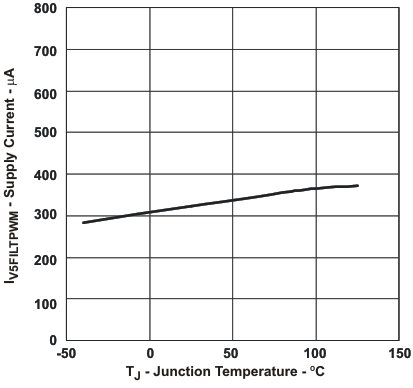
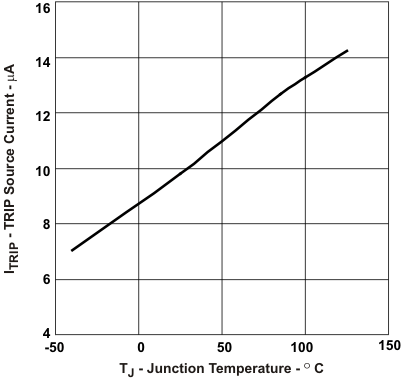
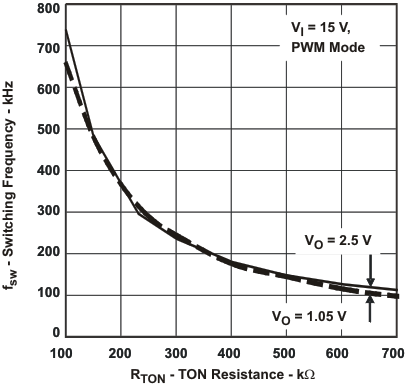
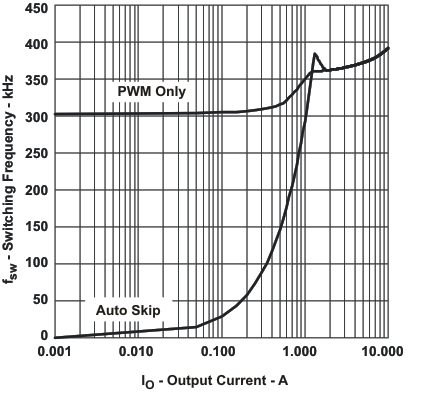
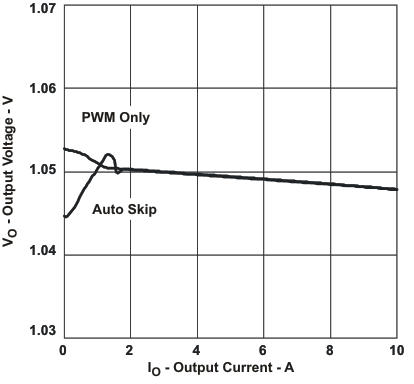
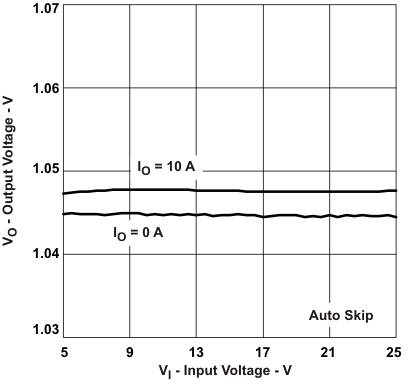
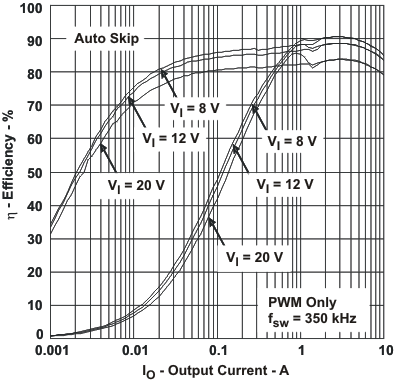
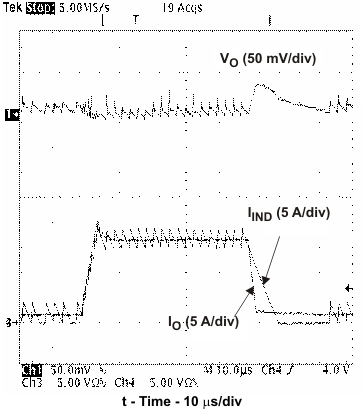
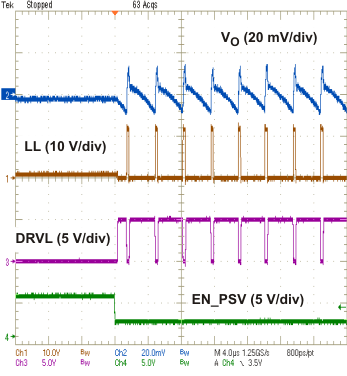
Auto-Skip to PWM
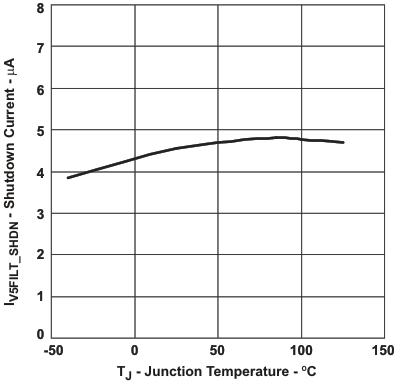
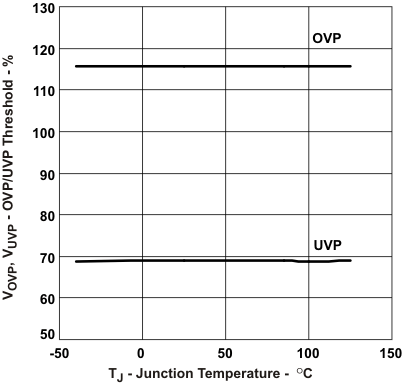
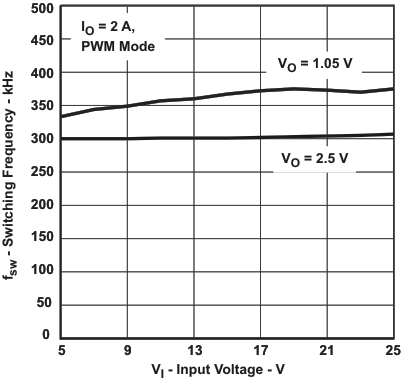
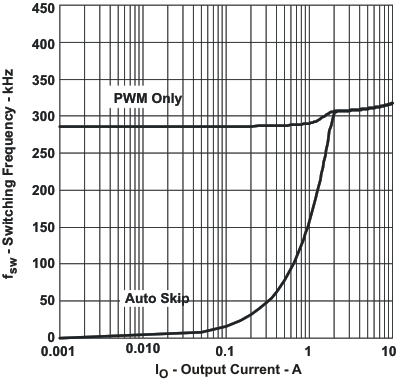
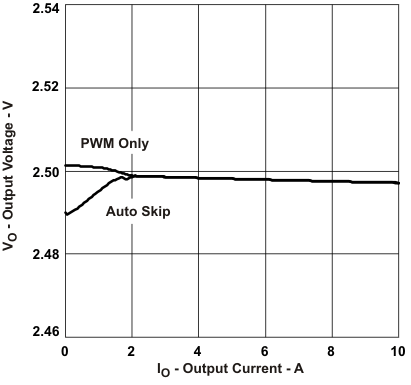
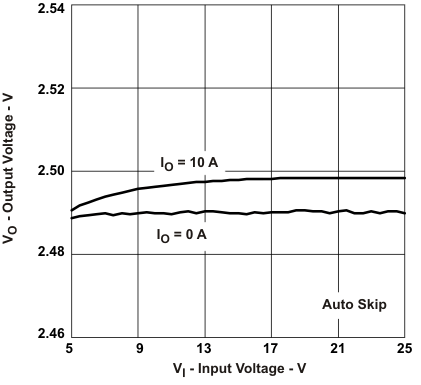
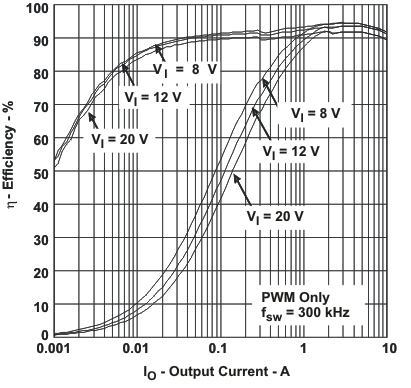
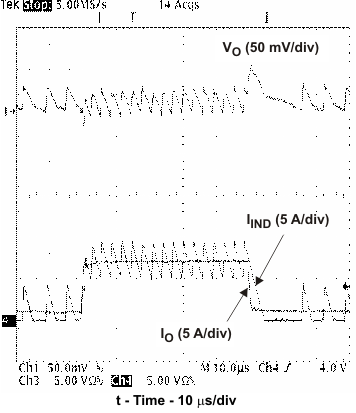
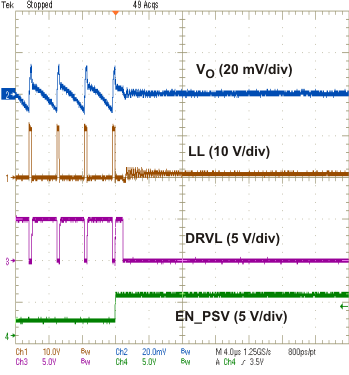
PWM to Auto-Skip